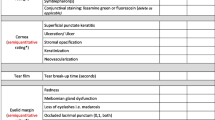Abstract
Background
Stevens-Johnson syndrome (SJS) and toxic epidermal necrolysis (TEN) are severe lifethreatening skin conditions. The most common cause of these manifestations is medications. Beside discontinued of the culprit drug, systemic corticosteroids were used as a primary treatment option among pediatric population. This study aimed to explore causative drugs (drug group/ latent period), treaments, complications, and treatment outcome (morbidity, mortality, length of hospital stay) of SJS and TEN in children.
Methods
A retrospective chart was reviewed during the period of 1992 to 2012 at Srinagarind Hospital, Faculty of Medicine, Khon Kaen University, Thailand. SJS and TEN were clinically diagnosed and confirmed by pediatric dermatologists. Other possible causes other than druginduced SJS and TEN were excluded.
Results
A total of 30 patients was recorded, including 24 (80%) SJS patients and 6 (20%) TEN patients. The mean age was 6.9 years (SD 4.4). Male to female ratio was 1.5:1. Antiepileptic drug group was the most common causative drug (n=18, 60%), followed by antibiotic drug group (n=8, 26.6%), and others (n=4, 13.3%) which included nonsteroidal antiinflammtory drugs (NSAIDs) and chemotherapy drugs. Systemic corticosteroids were used in 29 patients (96.6%). Intravenous immunoglobulin was used in one TEN patient (3.3%). There was a medium correlation between time to treatment (systemic corticosteroids) and the length of hospital stay (Spearman correlation coefficient=0.63, P=0.005). Two TEN patients (6.6%) died.
Conclusions
Carbamazepine was the most common causative drug of SJS and TEN in our study. The severity of skin detachment is not correlated to severity of ocular findings. However, the persistent of ocular complications up to one year is suggested for promptly appropriate ocular treatment in all SJS and TEN patients. Our data suggested that early administration of systemic corticosteroid may reduce the length of hospital stay and should be considered for the treatment of pediatric druginduced SJS and TEN.
Similar content being viewed by others
References
Schwartz RA, McDonough PH, Lee BW. Toxic epidermal necrolysis: Part I. Introduction, history, classification, clinical features, systemic manifestations, etiology, and immunopathogenesis. J Am Acad Dermatol 2013;69:173.e1-173. e13.
Ferrandiz-Pulido C, Garcia-Patos V. A review of causes of Stevens–Johnson syndrome and toxic epidermal necrolysis in children. Arch Dis Child 2013;98:998–1003.
Raucci U, Rossi R, Da Cas R, Rafaniello C, Mores N, Bersani G, et al. Stevens-johnson syndrome associated with drugs and vaccines in children: a case-control study. PLoS One 2013;8:e68231.
Ferrándiz-Pulido C, García-Fernández D, Domínguez-Sampedro P, García-Patos V. Stevens-Johnson syndrome and toxic epidermal necrolysis in children: a review of the experience with paediatric patients in a university hospital. J Eur Acad Dermatol Venereol 2011;25:1153–1159.
Del Pozzo-Magana BR, Lazo-Langner A, Carleton B, Castro-Pastrana LI, Rieder MJ. A systematic review of treatment of drug-induced Stevens-Johnson syndrome and toxic epidermal necrolysis in children. J Popul Ther Clin Pharmacol 2011;18:e121–e133.
Kirchhof MG, Miliszewski MA, Sikora S, Papp A, Dutz JP. Retrospective review of Stevens-Johnson syndrome/toxic epidermal necrolysis treatment comparing intravenous immunoglobulin with cyclosporine. J Am Acad Dermatol 2014;71:941–947.
Hung PC, Wang HS, Hsia SH, Wong AM. Plasmapheresis as adjuvant therapy in Stevens-Johnson syndrome and hepatic encephalopathy. Brain Dev 2014;36:356–358.
Borchers AT, Lee JL, Naguwa SM, Cheema GS, Gershwin ME. Stevens-Johnson syndrome and toxic epidermal necrolysis. Autoimmun Rev 2008;7:598–605.
Kim DH, Yoon KC, Seo KY, Lee HS, Yoon SC, Sotozono C, et al. The role of systemic immunomodulatory treatment and prognostic factors on chronic ocular complications in Stevens- Johnson syndrome. Ophthalmology 2015;122:254–264.
Tagajdid MR, Doblali T, Elannaz H, Hammi S, Belfequih B, Mrani S. Reactivation of cytomegalovirus in a patient with stevens-johnson syndrome-toxic epidermal necrolysis. Iran J Med Sci 2013;38(2 Suppl):195–197.
Shirai T, Sato A, Okano A, Honda K, Chida K, Iwata M, et al. Fulminant mycoplasma pneumoniae infection presenting with Stevens-Johnson syndrome & respiratory failure. Nihon Kyobu Shikkan Gakkai Zasshi 1991;29:1298–1304.
Yip LW, Thong BY, Lim J, Tan AW, Wong HB, Handa S, et al. Ocular manifestations and complications of Stevens–Johnson syndrome and toxic epidermal necrolysis: an Asian series*. Allergy 2007;62:527–531.
Hamilton GM, Fish J. Pediatric toxic epidermal necrolysis: an institutional review of patients admitted to an intensive care unit. J Burn Care Res 2013;34:e351–e358.
Singalavanija S, Limpongsanurak W. Stevens-Johnson syndrome in Thai children: a 29-year study. J Med Assoc Thail 2011;94 Suppl 3:S85–S90.
Naldi L, Crotti S. Epidemiology of cutaneous drug-induced reactions. G Ital Dermatol Venereol 2014;149:207–218.
Thammakumpee J, Yongsiri S. Characteristics of toxic epidermal necrolysis and Stevens-Johnson syndrome: a 5-year retrospective study. J Med Assoc Thai 2013;96:399–406.
Ding WY, Lee CK, Choon SE. Cutaneous adverse drug reactions seen in a tertiary hospital in Johor, Malaysia. Int J Dermatol 2010;49:834–841.
Chen P, Lin JJ, Lu CS, Ong CT, Hsieh PF, Yang CC, et al. Carbamazepine-induced toxic effects and HLA-B*1502 screening in Taiwan. N Engl J Med 2011;364:1126–1133.
Tassaneeyakul W, Tiamkao S, Jantararoungtong T, Chen P, Lin S-Y, Chen W-H, et al. Association between HLA-B*1502 and carbamazepine-induced severe cutaneous adverse drug reactions in a Thai population. Epilepsia 2010;51:926–930.
Ferrell PB, McLeod HL. Carbamazepine, HLA-B*1502 and risk of Stevens-Johnson syndrome and toxic epidermal necrolysis: US FDA recommendations. Pharmacogenomics 2008;9:1543–1546.
Rattanavipapong W, Koopitakkajorn T, Praditsitthikorn N, Mahasirimongkol S, Teerawattananon Y. Economic evaluation of HLA-B*15:02 screening for carbamazepine-induced severe adverse drug reactions in Thailand. Epilepsia 2013;54:1628–1638.
Bastuji-Garin S, Fouchard N, Bertocchi M, Roujeau JC, Revuz J, Wolkenstein P. SCORTEN: a severity-of-illness score for toxic epidermal necrolysis. J Invest Dermatol 2000;115:149–153.
Koh MJ, Tay YK. Stevens-Johnson syndrome and toxic epidermal necrolysis in Asian children. J Am Acad Dermatol 2010;62:54–60.
Su P, Aw CW. Severe cutaneous adverse reactions in a local hospital setting: a 5-year retrospective study. Int J Dermatol 2014;53:1339–1345.
Acknowledgments
We would like to acknowledge Dr. Watuhatai Paibool for assisting in collecting patients’ data.
Author information
Authors and Affiliations
Corresponding author
Rights and permissions
About this article
Cite this article
Techasatian, L., Panombualert, S., Uppala, R. et al. Drug-induced Stevens-Johnson syndrome and toxic epidermal necrolysis in children: 20 years study in a tertiary care hospital. World J Pediatr 13, 255–260 (2017). https://doi.org/10.1007/s12519-016-0057-3
Received:
Accepted:
Published:
Issue Date:
DOI: https://doi.org/10.1007/s12519-016-0057-3



